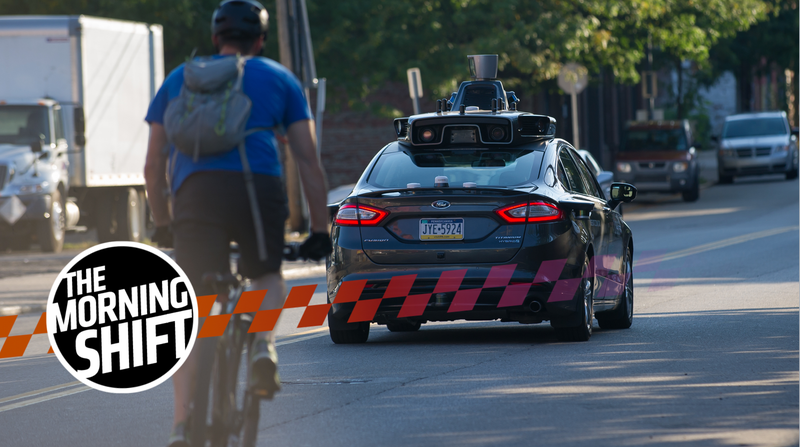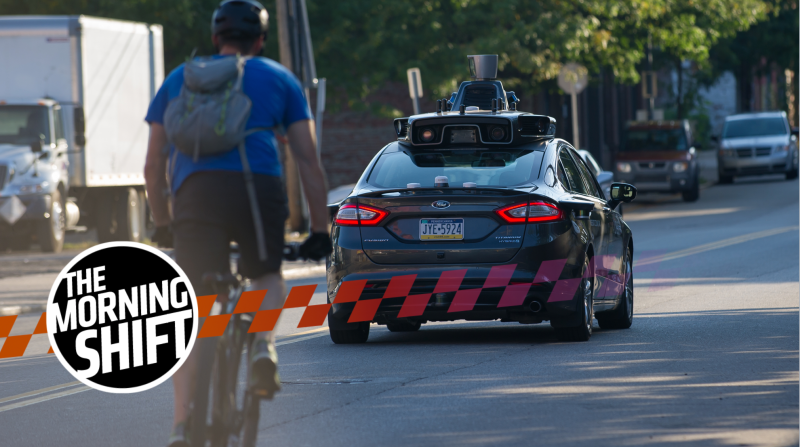
 The Morning ShiftAll your daily car news in one convenient place. Isn’t your time more important?
The Morning ShiftAll your daily car news in one convenient place. Isn’t your time more important? Robots and the future of ride-hailing, Tesla’s plans for expenses and cost cutting, potential spikes in gas prices on U.S. coasts, emissions wars, and more Nissan-Renault drama. All of this and more in The Morning Shift for Friday, May 17, 2019.
1st Gear: Robot Ride-Hailing Won’t Save Everything
One general idea in terms of ride-hailing is that once companies like Uber and Lyft can trade their living, breathing drivers who have households to support for autonomous technology, their operating costs will go down—effectively making ride-hailing cheaper for the consumer and more profitable for the companies (at the cost of people’s jobs, of course).
But according to a new study reported on by Automotive News, not even robot drivers will be able to turn ride-hailing into a sell-your-personal-car-already utopia. The study, done by the Massachusetts Institute of Technology, found that ride-hailing will still be more expensive per mile than traditional car ownership, even when the robots do make it to town.
The study found that, per mile in the San Francisco market, an automated taxi would range from $1.58 and $6.01 compared to the cost of 72 cents per mile for conventional car ownership. From the story:
“When we started going into this work, we found there’s a lot of hand-waving,” [MIT researchers Ashley] Nunes told Automotive News. “There was a notion that ‘All we have to do is remove the driver, assume a reduction in insurance, and there’s our great number.’ We said, ‘Let’s hold it up to scrutiny.’ It didn’t hold up.”
Advertisement
It might seem like repairs and technical issues would be a big cost in a fleet of robots, but the study actually found the big contributor to still-higher prices for autonomous ride hailing could end up being a traditional taxi problem.
From Automotive News:
Human-driven or autonomous, the taxi market will remain inefficient, Nunes says, because operators drive too many miles without a customer paying a fare. In San Francisco, the MIT researchers found a 52 percent utilization rate for ride-hailing and in Beijing, they say vehicles are utilized 56 percent of the time. Even if the vehicles had riders 100 percent of the time, Nunes says they’d still be unable to provide a fare that’s comparable to car ownership.
Cramming more paying passengers into the cars might be one solution, something that ride-hailing companies have rolled out in the form of Uber Pool and Lyft Line. But a fundamental problem with that model, Nunes says, is that steeper discounts need to be added to incentivize carpooling. Which cuts into revenue.
Costs associated with running teleoperations, in which remote human operators can intervene when self-driving taxis encounter confusing situations, will also hurt the competitiveness of the ride-hailing fleets.
Advertisement
Of course, that “per mile” stipulation is important. Some people need to travel far fewer miles in cars than others, meaning ride-hailing instead of ownership could be more beneficial to some. But if we’re talking price-per-unit cost, like a tag on the grocery-store shelves telling you how much per ounce an item costs, car ownership is still cheaper per each mile driven.
2nd Gear: Tesla to Review All of Its Expenses in New Cost-Cutting Plan
Tesla’s cutting costs again,as Reuters reports that company CEO Elon Musk told employees on Thursday, partly by “increas[ing] scrutiny” on the company’s expenses. Tesla’s profitability strugglesaren’t new, and neither is its tendency to burn cash. It sounds like Musk wants to reel that tendency in a bit.
Advertisement
After getting $2.7 billion as it ups production, Reuters reports, Musk sent an email to employees saying the money gives Tesla “only 10 months to achieve breakeven at the rate it was burning cash in the first quarter.”
That means cost cuts, according to the email Reuters viewed:
“That is why, going forward, all expenses of any kind anywhere in the word, including parts, salary, travel expenses, rent, literally every payment that leaves our bank account must (be) reviewed,” Musk said.
Tesla’s attempts to cut costs are not new. In April 2018, in an email sent to employees, Musk said he had instructed his finance team to “comb through every expense worldwide” to find possible cuts.
More recently, Tesla laid off 9 percent, and 7 percent of its workforce in June 2018, and January, respectively.
The new initiative comes after a tumultuous year for Tesla which has seen analysts and investors cast doubt on its ability to produce, sell and deliver enough cars to make a sustainable profit.
Advertisement
We’ll see how it all goes.
3rd Gear: Low Gasoline Supplies on U.S. Coasts Could Lead to Price Spikes
Summer is almost fully underway, which means people will set off on at least one vacation—many of them by driving. But Reuters reports that those trips may cost more than expected, since gas supplies on the U.S. East and West Coasts are at seasonal five-year lows and susceptible to price spikes.
Advertisement
Gas supply on the West Coast went down earlier in the year due to things like refining maintenance, unexpected outages and a drop in ethanol supply, Reuters reports, making gas over there already expensive. At the same time, the story said the American Automobile Association expects this Memorial Day weekend to have the second-highest travel volume since it started tracking numbers in 2000.
From the story:
Market participants have been sending supplies there instead of elsewhere as prices rose. California currently is posting the highest prices in the country, at an average of $4.054 per gallon, according to AAA. The state’s prices have been at their highest seasonally since 2014.
West Coast gasoline imports in April were up 62% from the same time last year, according to Matt Smith, director of commodity research at ClipperData.
That sapped cargoes from the East Coast, which has had its own refinery maintenance, traders said. Atlantic Coast imports in April were down 7% from last year, Smith said. Imports there have improved in May and so far are up 14% year-on-year.
Advertisement
In other words, this summer may be good for a staycation if you live on the East or West Coast.
4th Gear: California Regulator Threatens to Ban Gasoline Engines in Retaliation of Trump Administration’s Approach
It’s hard to remember the last time California and the Trump administration weren’t fighting over emissions regulations, and for good reason—we humans aren’t exactly being kind to Mother Earth or anything, to our own detriment.
Advertisement
Basically, President Donald Trump’s administration wants to ease up on the Obama-era fuel targets, and California wants none of that. The state has generally had the ability to set its own rules for fuel economy, but the Trump administration even threatened to try to take that away.
In the latest development, though, Automotive News reports that California Air Resources Board Chair Mary Nichols said California will meet any easing up of standards by the Trump administration with stricter rules from its side. That included the possibility of a ban on gasoline engines, according to the story:
“CARB will be exploring ways to ensure communities get the reductions of air pollution they so desperately need to keep the air clean and breathable — and continue to fight climate change,” Nichols said in draft remarks prepared for an event Thursday.
“That might mean, for example, tougher requirements for low-carbon fuels, looking at tighter health-protective regulations on California refineries, doubling down on our enforcement efforts on mobile and stationary sources — and might lead to an outright ban on internal combustion engines.”
Advertisement
According to Automotive News, the U.S. Environmental Protection Agency didn’t respond to a request for comment by the time the story published.
5th Gear: Nissan Keeps Its CEO, in Spite of Everything
The Nissan-Renault-alliance drama since Carlos Ghosn’s arrest over alleged financial misconduct in November has been plentiful. Everybody’s mad at each other, everybody’s pointing fingers, and people are getting kicked out of the family and replaced with new ones.
Advertisement
But one of those people won’t be Nissan CEO Hiroto Saikawa, whose future at Nissan has been a question since this began.
Saikawa, who accused Ghosn of financial misconduct, hinted in January that he planned to step down after the mess all unfolded, before later going back on that statement and saying he’d stick around for a few years. Nissan agrees, Reuters reports, and is keeping him around—despite Renault’s prior urges for a change in leadership over there.
Saikawa, as Reuters notes, has opposed a full integration of Nissan and Renault for a long time. Ghosn wanted a merger. From the story:
Nissan has proposed that Renault Chief Executive Thierry Bollore will join the board, while Renault Chairman Jean-Dominique Senard will remain on it. The board will be increased to 11 members from eight, and will include seven outside directors. The proposals will be put to a shareholder vote in June.
The make-up of Nissan’s board has vast implications for the Nissan-Renault alliance. The unequal relationship between them – smaller Renault has the bigger stake in Nissan – has long been a source of friction.
The board unanimously backed Saikawa, even while acknowledging he may have not done enough to rein in Ghosn, one external director said. Ghosn, who has been charged with financial misconduct, has denied wrongdoing. […]
However, a source close to Senard said there had been no vote earlier this week, unanimous or otherwise, on Saikawa’s reappointment as CEO.
Advertisement
But if there’s anything we can be sure of, it’s that the drama will continue.
Reverse: The Toyota Camry Goes Hybrid
Toyota announced plans for the Camry to go hybrid on May 17, 2005,according to Automotive News. Of course, even hybridization can’t prevent a Camry dent.
Advertisement
Neutral: Do You See the Future as Autonomous Taxis Everywhere?
Or will you hold onto your steering wheel and manual shifter until your last dying breath? (Preferable.)















